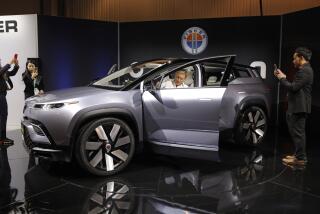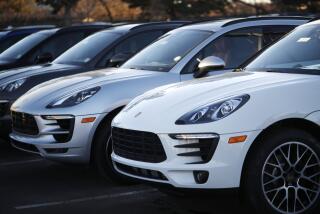Saab hits a home run
FEW commercials in history are more cringe-worthy than those of Saab’s current “Born From Jets” campaign, in which a Swedish-built Saab Viggen fighter morphs into wait for it a Saab 9-7X SUV — Yah, Sven, dat’s a guut one. As most devoted Saab-omites know, the 9-7X is born from the rather less-than-jet-like Chevy Trailblazer, built and re-badged in that famous Scandinavian enclave of Moraine, Ohio. For a company purchased by General Motors in 1999 and drowning in badge-engineered inauthenticity, these commercials throw the Saab image a big, rusty anchor.
GM should know better. Indeed, it does, as evidenced by the Saab 9-3 SportCombi, an absolutely brilliant piece of global car-building that retains all the historic vibe — the willowy feel, the Eurostil design, the infatuating quirkiness, even kinkiness — of Saabs, yet still manages to start in the morning.
As God intended, the 9-3 SportCombi is built in Trollhattan, Sweden — where that new-car smell has the vaguest hint of herring — on the same line as the 9-3 sedan (the 9-3 convertible is assembled by Magna Steyr in Austria). Saab’s 9-3 shares GM’s mid-size, front-drive Epsilon platform with the Chevy Malibu/Maxx and Pontiac G6, though mercifully you can’t tell.
The sedan and wagon have MacPherson strut front suspension and multi-link rear with what Saab calls ReAxe, a kind of passive rear-steer that allows a little line-following wheel deflection as the car corners hard. The SportCombi is identical to the sedan from the B-pillars forward. Aft of that point, the chassis is transversely reinforced at the C- and D-pillars. According to Saab, the SportCombi has chassis stiffness nearly equal to the sedan and gains a mere 88 pounds in the wagon-izing.
Now, of course, I’m biased. I think sport wagons are the coolest kinds of cars on Earth, cars that give virtually nothing away compared with their sport sedan siblings while offering major cargo- and people-moving qwan. Our test vehicle, a SportCombi with the performance Aero package, boldfaces the point. A newly turbocharged version of the GM-corporate 2.8-liter V6 generates gusts of up to 250 hp (base SportCombi’s get the turbo-four with 210 hp).
The turbo-six beautifully emulates the character of the old 900 turbos — a little soft at the bottom-end of the tach then free-spooling and torque-rich in the upper registers as the twin-scroll turbo comes up to speed. Stirred with a six-speed manual transmission, the SportCombi Aero accelerates to 60 mph in under 7 seconds and has oodles (a Swedish word, I think) of mid-range thrust and aggression. Stick the car in the long-legged sixth gear and it will motor effortlessly from Malmo to Stockholm.
It’s a funny thing about Saabs, you know? Most sporty cars have an intensely and even gratuitously stiff and hard feeling to them — the clutch, steering, brakes and gearshift require some muscling. In Saabs everything is feather light and kind of rubbery, as if the controls were all connected by bungee cords.
Yet it all seems to work together. In the SportCombi Aero, the car has this charming, loose-limbed cornering behavior: Turn in and lift off the gas a bit and the car rolls, pitches and bites, gathering cornering forces as the rear-steering feeds in progressively more grip. Roll back on the gas and the front tires scrabble for traction and pull the car out with nice power-on front drift. Cool.
One reason the SportCombi has such character is that it retains Saab’s like-it-or-lump-it interior design, with its odd but distinctive ergonomics. This is surely the most grown-up interior of any GM car sold in the U.S., with rich black soft-touch surfaces, affirmative switchgear and — in the Aero — warm metal accents. I love the car’s cockpit, though it’s by no means flawless. The nav system resisted my best efforts to get it to display street names. The radio display is part of the small LCD readout on top of the dash. It doesn’t have enough room for the RDC information, so it drags it out interminably, as in “Ludwi g Von Bee thoven Pi ano Sona ta #4.” This i s stupi d.
Despite Saab’s best efforts to deflect your notice with the “SportCombi” neologism, this vehicle is, after all, a wagon, though an uncommonly handsome one. The steeply sloped rear glass and gradually tapering roofline, combined with the blacked-out roof pillars and dark-tinted glass, lend the car a rakish and slightly menacing effect. The Aero package skirts the car in athletic body cladding. When I look at the SportCombi I don’t think Aero so much as “arrow,” with its fletches bent sleek by the wind.
The rear cargo hold has some surprises, including a smaller storage compartment under the load floor. The space behind the rear seats measures a generous 29.7 cubic feet. With the 60/40 rear seats folded, the cargo hold expands to 72.3 cubic feet, which is more than that of BMW X5, Porsche Cayenne or Range Rover Sport.
Saabs remain an acquired taste — but I guess I’ve acquired it. True, the SportCombi doesn’t have available all-wheel drive like competitors Volvo V50 and Audi A4 Avant. Nor does it have rear-wheel drive like the BMW 330xi, so at the theoretical handling limits the car suffers by comparison. But in the real world, few cars under $40,000 are so lovable, likable, practical and cool.
The next-generation of 9-3s will be built in GM’s plant in Russelsheim, Germany, and while this might be a good idea from an industrial perspective, it plays havoc with the imagery of Saab, whose Swedish provenance is sine qua non. Born from jets? Take Saabs out of Sweden and the company’s glorious aircraft heritage becomes only a cynical advertising tagline.
*
Automotive critic Dan Neil can be reached at dan.neil@latimes.com.
*2006 Saab 9-3 SportCombi Aero
Base price: $33,620
Price, as tested: $38,160
Powertrain: Turbocharged and intercooled, 24-valve, DOHC 2.8-liter V6 with variable intake valve timing; six-speed manual transmission; front-wheel drive
Horsepower: 250 at 5,500 rpm
Torque: 258 pound-feet at 2,000 rpm
Curb weight: 3,285 pounds
0-60 mph: Under 7 seconds
Wheelbase: 105.3 inches
Overall length: 183.2 inches
EPA fuel economy: 17 miles per gallon city, 28 mpg highway
Final thoughts: No red herring.






